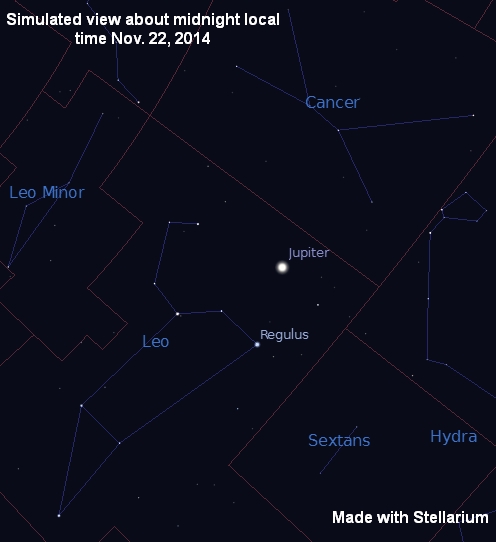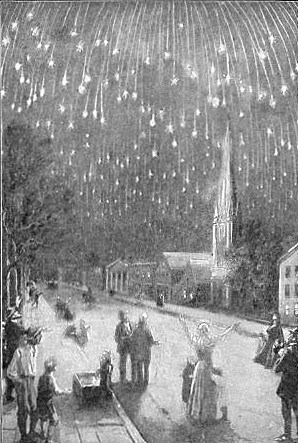¡SkyCaramba! Weekly astronomy blog for the week ending November 15, 2014
 Jack Horkheimer’s “King of the Planets” is in the constellation that’s the “King of the Jungle” this month. And we may get a regal meteor shower too.
Jack Horkheimer’s “King of the Planets” is in the constellation that’s the “King of the Jungle” this month. And we may get a regal meteor shower too.
Times vary from night to night and place to place. But you’ll see Jupiter rising around midnight. Not long after that, the stars of Leo come up. The big planet is just a little above the bright star Regulus, known as the heart of Leo.
Regulus is a bluish star about 79 light years away. It’s at the bottom of a backward question mark or sickle. For thousands of years, various cultures have look at this part of the sky and told stories of a lion there. The Sumerians, Babylonians, Persians, Greeks, and Romans were among them. However, to the ancient Chinese, this constellation represented a horse. And some make the case that the Incas recognized it as a puma.
To the Greeks, Leo was the Nemean Lion, a beast that fell from the moon and menaced Corinth until Heracles slew him. The constellation is thought to have inspired the lion on the British coat of arms and the Israeli Lion of Judah.
Jupiter is slowly moving toward Regulus (latin for little King). It won’t make it to the star this month. In fact, the planet’s apparent movement will slow down until it is said to be stationary in early December. Then Jupiter will begin retrograde motion, that is, to the west. It will continue retrograde motion until April when it is near the heart of Cancer. Then direct (eastward) motion will resume.
The planet and the constellation are all high in the sky together as dawn approaches in November. In the next few months, they’ll rise earlier until they’re up all night together in February.
November is also the month for the famous meteor shower. Some past meteor showers have been spectacular with hundreds of meteors per hour. The most recent such event was in 2001. We’re not expecting the same high meteor count in 2014, but you should still be able to see a few Leonids after midnight for several nights with a peak around the 16th.
 These meteors come from dust entering Earth’s atmosphere as our planet goes through old dust trails from Comet Tempel-Tuttle. It’s currently moving away from the sun and won’t be very close again until 2031. For a year or two after that close approach, we may see more spectacular Leonid meteor showers. In the meantime, Leonid showers will be modest.
These meteors come from dust entering Earth’s atmosphere as our planet goes through old dust trails from Comet Tempel-Tuttle. It’s currently moving away from the sun and won’t be very close again until 2031. For a year or two after that close approach, we may see more spectacular Leonid meteor showers. In the meantime, Leonid showers will be modest.
Tempel-Tuttle certainly leaves a lot of comet dust behind. The Leonids in 1833 numbered incredibly, according to some sources, more than 100,000 meteors per hour at their peak. One may have seen two dozen or more meteors at the same time! People described it as a night when the stars fell out of the sky. Even though comet trails disperse over time, Tempel-Tuttle trails that are hundreds of years old still produce peaks in the dozens or hundreds per hour.
The best viewing for the Leonids is after midnight. ¡SkyCaramba!